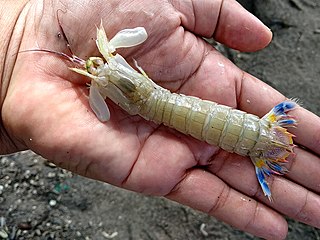
Anaspidesidae is a family of freshwater crustacean that is endemic to Tasmania, Australia. The family contains 3 living genera. This group of crustaceans are considered living fossils. They are commonly and collectively known as the Tasmanian anaspid crustaceans.

Anaspidacea is an order of crustaceans, comprising eleven genera in four families. Species in the family Anaspidesidae vary from being strict stygobionts to species living in lakes, streams and moorland pools, and are found only in Tasmania. Koonungidae is found in Tasmania and the south-eastern part of the Australian mainland, where they live in the burrows made by crayfish and in caves. The families Psammaspididae and Stygocarididae are both restricted to caves, but Stygocarididae has a much wider distribution than the other families, with Parastygocaris having species in New Zealand and South America as well as Australia; two other genera in the family are endemic to South America, and one, Stygocarella, is endemic to New Zealand.
Gonodactylellus is a genus of mantis shrimp. The genus was first described by Raymond Manning in 1995.

Anaspides tasmaniae is a species of fresh water crustacean of the family Anaspididae found in Tasmania. It is also known by the common names "mountain shrimp" or "chris' pseudo-mantis". It has been described as a "living fossil". A. tasmaniae lives in tarns and creeks over 300 metres above sea level, and is found in Lake St Clair and Clarence Lagoon.

Scolonida gracilis is a species of squat lobster in the family Munididae.

Acanthosquilla is a genus of stomatopod crustacean. The American carcinologist Raymond B. Manning named and first circumscribed the genus in 1963. As of 2018, the World Register of Marine Species recognizes the following eight species:
Aridulodrilus molesworthae is a large Australian earthworm occurring, unusually, in a semiarid region of New South Wales. It was recognised as a species of Megascolecidae, a family with extreme diversity in the wetter coastal regions of the continent, but distinguished as a new monotypic genus Aridulodrilus, a name derived from Latin meaning a semi-desert worm. This animal was first recorded by a Broken Hill property's manager, Rosalind Molesworth, after substantial rain had brought them to the surface; the specific epithet molesworthae honours its discoverer.

Parawaldeckia is a genus of amphipod crustacean in the family, Lysianassidae. and was first described by Thomas Roscoe Rede Stebbing in 1910. The type species is Parawaldeckia thomsoni.
Amaryllis migo is a species of crustacean in the family Amaryllididae, and was first described in 2002 by James K. Lowry and Helen E. Stoddart.
Natatolana buzwilsoni is a species of crustacean in the family Cirolanidae, and was first described by Stephen John Keable in 2006. The species epithet, buzwilsoni, honours George ('Buz') Wilson.
Natatolana flexura is a species of crustacean in the family Cirolanidae, and was first described by Stephen John Keable in 2006.
Natatolana helenae is a species of crustacean in the family Cirolanidae, and was first described by Stephen John Keable in 2006. The species epithet, helenae, honours Helen Stoddart.

Erugosquilla is a genus of crustaceans belonging to the family Squillidae. The genus was first described in 1995 by Raymond Brendan Manning. The type species is Erugosquilla massavensis(Kossmann, 1880).
Erugosquilla septemdentata is a species of shrimp in the family, Squillidae, and was first described in 1994 by Shane T. Ahyong as Oratosquilla septemdentata. The name was revised to Erugosquilla septemdentata in 1995 by Raymond B. Manning.
Anaspides clarkei is a species of freshwater crustacean in the family Anaspidesidae, and was first described in 2015 by Shane Ahyong
Hickmanoxyomma cavaticum is an endangered species of arachnid, in the family, Triaenonychidae. It was first described in 1958 by Vernon Victor Hickman as Monoxyomma cavaticum, but was reassigned to the genus Hickmanoxyomma in 1990 by Glenn Hunt.
Anaspides jarmani is a species of freshwater crustacean in the family Anaspidesidae, and was first described in 2015 by Shane Ahyong
Anaspides swaini is a species of freshwater crustacean in the family Anaspidesidae, and was first described in 2015 by Shane Ahyong

Anaspides driesseni is a species of freshwater crustacean in the family Anaspidesidae, and was first described in 2023 by Christoph Höpel, Stefan Richter & Shane Ahyong. In 2016 Ahyong discussed three morphologically different forms of A. swaini occurring in three different drainage systems.

Koonaspides is an extinct genus of fossil crustacean in the family Anaspidesidae, from Early Cretaceous (Aptian) Koonwarra Fossil Beds in eastern Victoria, Australia. The only known species within the genus is Koonaspides indistinctus. Along with the Triassic genus Anaspidites, this is one of two known fossil members of this family.









